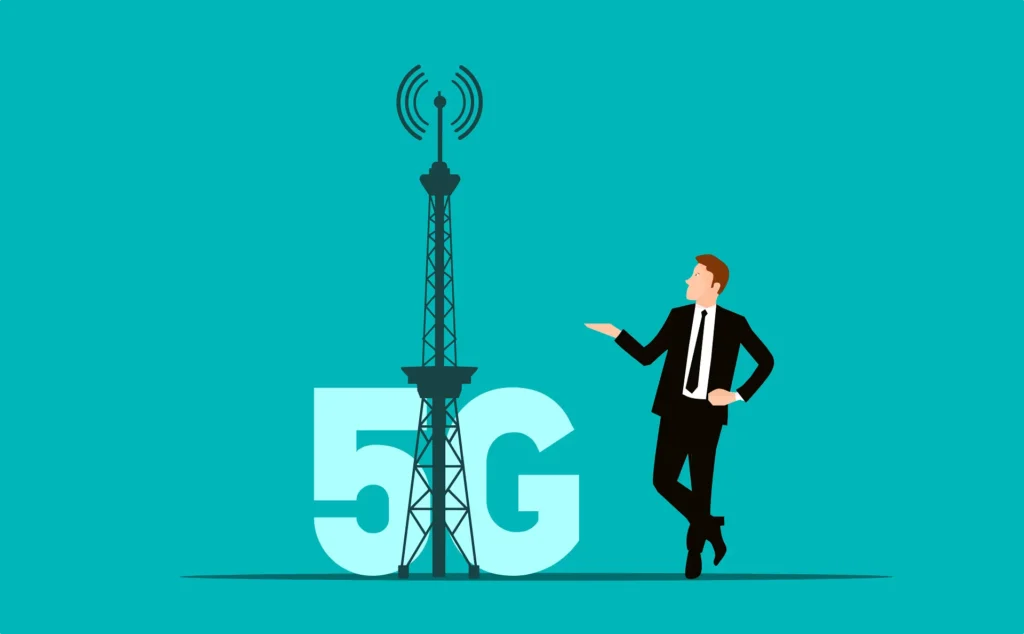5G is no longer just a buzzword tossed around at tech conferences. It’s here — and being rolled out in cities, industries, and devices all over the world. With its promise of ultra-fast speeds, low latency, and massive device connectivity, 5G is reshaping how we think about mobile networks.
But the big question for developers is:
Does 5G actually change how we build applications?
Or is it just an infrastructure upgrade that someone else has to worry about?
In this post, we’ll break it down in simple terms. We’ll explore how 5G is influencing everything from mobile app performance to backend architecture. Whether you’re building real-time apps, exploring edge computing, or just curious about what’s next — this guide will help you understand what 5G means for your work and how you can stay ahead.
What is 5G and Why Should Developers Care?
A Quick Recap of 5G
5G stands for the fifth generation of mobile network technology. It’s a major upgrade from 4G — not just a little faster, but designed for a new era of connectivity.
Here’s how 5G compares to 4G in simple terms:
- Speed: 5G can deliver download speeds of up to 10 Gbps, compared to 4G’s typical 100 Mbps. That’s about 10–100x faster.
- Latency: 5G can reduce latency to as low as 1 millisecond, while 4G usually sits around 30–50 milliseconds. This means real-time communication is finally possible.
- Bandwidth: 5G supports more devices per square kilometer, which is crucial for growing networks of smart devices, sensors, and IoT systems.
For example, while 4G struggles with high-traffic areas (like stadiums or conferences), 5G can handle thousands of simultaneous connections without breaking a sweat. It’s not just about speed — it’s about reliability and capacity, too.
Key Benefits That Matter to Developers
5G isn’t just a telecom upgrade. It opens up new possibilities for how apps work and what they can do. Here’s why developers should pay attention:
- 📶 Near-Instant Data Transfer
Apps can now fetch or send data almost instantly. Think real-time multiplayer games, live-streamed AR filters, or voice translation apps with zero delay. - 📱 More Connected Devices (IoT & Wearables)
5G supports dense networks of small devices. Developers can now build applications that connect hundreds or thousands of sensors or wearables without worrying about network congestion.
Example: Smart homes, logistics tracking systems, or city-wide environmental sensors. - ⏱️ Reliable Performance for Real-Time Applications
Low latency and consistent bandwidth make 5G ideal for VR, AR, telemedicine, remote robotics, and autonomous systems.
Example: Imagine a remote surgery robot reacting in real-time to a surgeon’s hand — that’s only possible with ultra-low latency.
These benefits mean developers can go beyond just mobile and web — 5G opens the door to entirely new categories of applications that weren’t practical before.
Development Opportunities with 5G
5G isn’t just about improving existing apps — it opens the door to entirely new types of applications. Faster speeds, lower latency, and broader device support mean developers can now build richer, smarter, and more immersive experiences than ever before.
More Sophisticated Mobile Apps
With 5G, developers are no longer limited by network constraints. You can now build mobile apps that handle high-resolution video, real-time communication, and augmented reality overlays — all on the go.
Features that were once considered “too heavy” for mobile are now possible:
- Real-time video processing
- Live subtitles and voice translation
- 3D object rendering in real-world environments
Example:
Imagine a real-time language translation app that uses your phone’s camera and microphone to:
- Record someone speaking
- Translate the voice instantly
- Overlay translated subtitles on the video in real time
This kind of smooth experience is finally feasible with 5G.
IoT and Smart Devices Ecosystem
5G is built to handle massive device connectivity, which is crucial for the growing Internet of Things (IoT). This means developers can create apps that communicate with thousands of devices at once — all without network slowdowns.
What this unlocks:
- Apps that monitor and control smart homes
- Systems that track logistics and supply chains in real time
- Platforms that collect data from wearables, sensors, and vehicles
Example:
A logistics company could use an app to track every delivery truck, package, and warehouse sensor across a country — all in real time, with up-to-date location, temperature, and inventory data. That’s a huge step up from periodic status updates.
XR (AR/VR) and Immersive Experiences
5G’s ultra-low latency makes extended reality (XR) — which includes augmented reality (AR) and virtual reality (VR) — much more practical and enjoyable. These apps rely on real-time interaction, and 5G helps eliminate lag and motion delay.
This opens up new creative and commercial use cases:
- Virtual classrooms with live, interactive 3D lessons
- AR-based training for engineers, medical staff, or field workers
- Immersive gaming experiences that were only possible on high-end PCs
Example:
A company could create an AR training simulation for factory workers. Instead of watching videos, workers wear AR glasses and learn by doing — guided step-by-step with real-time instructions and feedback, all powered by 5G.
These use cases aren’t just cool ideas — they’re practical, market-ready opportunities for developers to explore today. With 5G, you’re not just making better apps. You’re making smarter, faster, and more connected experiences that weren’t possible before.
Key Challenges Developers Should Prepare For
While 5G opens up exciting new opportunities, it also brings a few new challenges that developers should keep in mind. Building for a 5G-enabled world requires more than just faster data — it means adapting your apps to new demands on performance, infrastructure, and security.
Increased Data and Battery Use
With faster speeds and richer features, apps tend to use more data and more power. Streaming high-resolution video, processing real-time AR, or handling large sensor inputs can quickly drain a user’s battery — or strain backend systems.
What developers can do:
- Optimize media files (e.g., use adaptive video streaming)
- Use efficient data formats (like Protocol Buffers instead of JSON)
- Offload heavy processing to the edge or cloud
- Monitor app energy consumption during development
Example:
A mobile AR app that overlays real-time directions on a live video feed may look great, but if it drains a phone’s battery in 20 minutes, users won’t stick around. Performance tuning becomes just as important as features.
More Complex Testing Environments
5G apps often depend on a combination of edge servers, cloud services, and device interactions — all happening in real time. This creates a more complex testing landscape.
Challenges include:
- Simulating 5G network conditions (like low latency and high bandwidth)
- Ensuring consistent performance across regions with varying 5G coverage
- Testing how edge and cloud components interact under load
What developers can do:
- Use tools that simulate network conditions (e.g., iPerf, Network Link Conditioner)
- Run integration tests that include edge devices and services
- Consider “chaos testing” to simulate failures in 5G-related components
Example:
A telehealth app might work flawlessly on a 5G test device but fail in areas with spotty coverage. Testing in realistic, diverse environments is key to delivering reliable experiences.
Security Considerations
5G allows for more connected devices — and with that comes a larger attack surface. From IoT sensors to edge nodes, each connected component could become a potential security risk.
Key areas of concern:
- Insecure APIs between devices and servers
- Weak encryption on edge devices
- Lack of validation or authentication for device communication
What developers can do:
- Use HTTPS and strong encryption by default
- Implement proper authentication and authorization
- Validate inputs and use secure coding practices
- Regularly audit and update third-party libraries
Example:
A smart home app that communicates with dozens of devices must ensure that only verified devices are allowed to connect and that data can’t be intercepted or tampered with.
Preparing for these challenges upfront can save time, prevent bugs, and protect users. 5G brings new opportunities — but developers need to stay smart, secure, and efficient to take full advantage of them.
Technologies and Tools to Explore
To build effective 5G-enabled applications, developers can leverage a growing set of tools and platforms designed to handle the unique demands of this new network. Here are some key technologies worth exploring:
- Edge Computing Platforms
Services like AWS Wavelength and Azure Edge Zones bring cloud compute and storage closer to the user, reducing latency. They let you run parts of your app at the network edge, enabling faster responses and better real-time performance. - Low-Latency Protocols
Protocols such as WebRTC and MQTT are designed for fast, reliable communication with minimal delay. WebRTC is great for real-time audio/video streaming and peer-to-peer data, while MQTT is lightweight and ideal for IoT messaging between devices. - Cloud-Native Architecture
Using microservices and serverless computing helps apps scale efficiently and handle distributed workloads common in 5G environments. Breaking applications into smaller, independent services also makes it easier to deploy updates and manage complex edge-cloud interactions. - Simulation and Testing Tools for 5G
Tools like Open5GS, an open-source 5G core network simulator, help replicate 5G conditions for development and testing. iPerf is widely used for measuring network bandwidth and performance, letting you simulate different network speeds and latencies to optimize your app.
Exploring these technologies will give you a solid foundation to build applications that fully leverage 5G’s speed and connectivity. Experimenting early can give you a head start in mastering the 5G app landscape.
Should You Start Building for 5G Today?
5G is expanding quickly, but its availability and impact still vary depending on your region and the type of app you’re building. Before fully committing to 5G-first development, it’s important to take a balanced approach.
Consider These Points:
- Adoption Varies by Location
While major cities and developed countries are seeing fast 5G rollouts, many areas still rely on 4G or slower networks. Building apps that only work well on 5G could limit your user base. - Know Your Use Case
If your app benefits significantly from low latency or high bandwidth — like AR/VR, real-time gaming, or remote healthcare — then prioritizing 5G features makes sense. But simpler apps or those targeting broader audiences should remain backward compatible. - Be 5G-Aware, Not 5G-Only
Instead of designing exclusively for 5G, build apps that adapt gracefully to different network conditions. Use techniques like adaptive streaming, offline support, and scalable architectures to reach the widest audience.
Industries Leading the 5G Charge
Some sectors are already embracing 5G’s potential and pushing innovation:
- Healthcare: Remote surgeries, telemedicine, and wearable health monitors rely on 5G’s real-time capabilities.
- Gaming: Cloud gaming and AR/VR experiences need low latency to keep players engaged.
- Logistics: Real-time tracking and smart inventory systems benefit from 5G’s device density and speed.
- Media & Entertainment: Ultra-high-definition live streaming and interactive content thrive with faster networks.
In summary, start experimenting with 5G technologies now, but keep your app flexible and accessible for all users. Staying informed and adaptable is the best way to stay ahead as 5G continues to grow.
Final Thoughts
5G is more than just faster internet—it’s a game changer for how applications are built and experienced. The technology offers real advantages like ultra-low latency, massive device connectivity, and the ability to process data closer to users through edge computing. However, to fully benefit from 5G, developers need to rethink their application architecture and be mindful of new challenges like increased data use and security risks.
Key Takeaways:
- 5G enables richer, more interactive, and real-time applications that weren’t practical before.
- Edge computing is essential to reduce latency and improve app responsiveness.
- Developers must optimize for battery, network variability, and security.
- Testing in real-world 5G conditions is critical to deliver reliable experiences.
If you’re a developer or IT professional, now is a great time to start experimenting with 5G-related technologies like edge platforms and low-latency protocols. Even small projects or prototypes can give you valuable insights and a competitive edge.
Remember, staying informed and adaptable is key to staying ahead in the fast-moving world of tech. Keep learning, testing, and innovating — 5G is here to stay, and the future of app development is ready for those who are prepared.
Wrapping Up
5G is transforming the way we build and experience applications, opening doors to faster, smarter, and more connected solutions. While it comes with new challenges, the opportunities for developers to innovate and create next-level apps have never been greater.
Ready to dive deeper into 5G and modern app development?
Subscribe to StayAhead.tech for more practical guides and insights,
or share your thoughts below — how do you see 5G impacting your projects?
Want to explore related topics?


